The important part Little Melton School plays in the life of our community today is very well recognised and appreciated, but what is not so well known is that it is following in a tradition that may well have started here nearly three hundred years ago, when the first teacher we know of was appointed for this village.
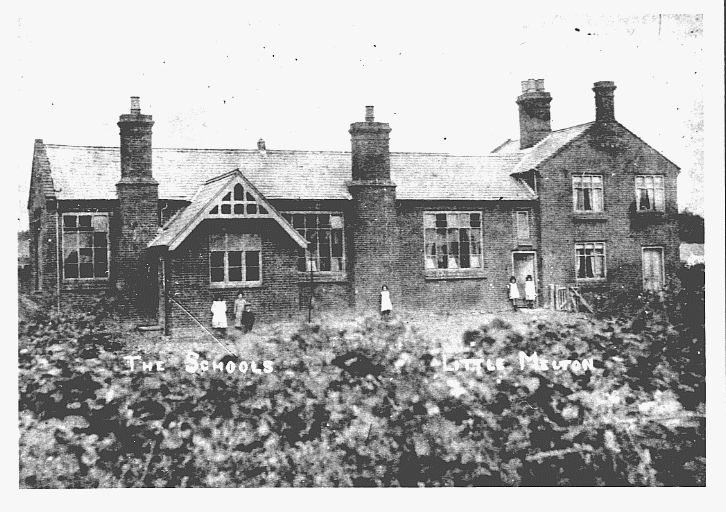 The school in early 1900sFor a long period, any person who wanted to take up either the profession of teaching, or of ministry in the Anglican Church, or of medicine, was required by law to declare his allegiance to the Church of England and to the sovereign, before being entrusted with the care of ‘the mind, body and soul’ of pupils, parishioners or patients. This declaration of faith in the teaching of the Established Church and loyalty to the Crown was known as “subscribing’, and a record of many who signed the appropriate documents can be found in the Subscription Books of the Diocese of Norwich which still survive for the years between 1637 and 1800. In return, all who signed, providing they were suitably qualified, were granted a licence to follow their profession. This system was finally abolished in 1869, but it is from these books that we find details of where these early professional people practised their skills.
The school in early 1900sFor a long period, any person who wanted to take up either the profession of teaching, or of ministry in the Anglican Church, or of medicine, was required by law to declare his allegiance to the Church of England and to the sovereign, before being entrusted with the care of ‘the mind, body and soul’ of pupils, parishioners or patients. This declaration of faith in the teaching of the Established Church and loyalty to the Crown was known as “subscribing’, and a record of many who signed the appropriate documents can be found in the Subscription Books of the Diocese of Norwich which still survive for the years between 1637 and 1800. In return, all who signed, providing they were suitably qualified, were granted a licence to follow their profession. This system was finally abolished in 1869, but it is from these books that we find details of where these early professional people practised their skills.
The important part Little Melton School plays in the life of our community today is very well recognised and appreciated, but what is not so well known is that it is following in a tradition that may well have started here nearly three hundred years ago, when the first teacher we know of was appointed for this village.
 The school in early 1900sFor a long period, any person who wanted to take up either the profession of teaching, or of ministry in the Anglican Church, or of medicine, was required by law to declare his allegiance to the Church of England and to the sovereign, before being entrusted with the care of ‘the mind, body and soul’ of pupils, parishioners or patients. This declaration of faith in the teaching of the Established Church and loyalty to the Crown was known as “subscribing’, and a record of many who signed the appropriate documents can be found in the Subscription Books of the Diocese of Norwich which still survive for the years between 1637 and 1800. In return, all who signed, providing they were suitably qualified, were granted a licence to follow their profession. This system was finally abolished in 1869, but it is from these books that we find details of where these early professional people practised their skills.
The school in early 1900sFor a long period, any person who wanted to take up either the profession of teaching, or of ministry in the Anglican Church, or of medicine, was required by law to declare his allegiance to the Church of England and to the sovereign, before being entrusted with the care of ‘the mind, body and soul’ of pupils, parishioners or patients. This declaration of faith in the teaching of the Established Church and loyalty to the Crown was known as “subscribing’, and a record of many who signed the appropriate documents can be found in the Subscription Books of the Diocese of Norwich which still survive for the years between 1637 and 1800. In return, all who signed, providing they were suitably qualified, were granted a licence to follow their profession. This system was finally abolished in 1869, but it is from these books that we find details of where these early professional people practised their skills.
1600s and 1700s
1600s and 1700s
There was no overall system of education in the 17th, 18th and early 19th centuries, but where schools existed, they were mainly of two types, ‘Grammar’ schools, based on the teaching of Latin and Greek, (essential for university entrance), and ‘English’ schools, where pupils were taught the ‘Three Rs’, reading, writing and arithmetic. Teaching was not necessarily given in school buildings, as we know them now, for classes were often held in the teacher’s own home, or alternatively in the Parson’s study in a Rectory or Vicarage, offering education to children whose family circumstances would probably not otherwise have permitted them the ‘luxury’ of schooling. Many leading figures, however, felt that education should be designed around a person’s ‘standing’ in life, often holding the belief that ‘too much learning’ would make the poor dissatisfied and unfit for laborious employment – a feeling that persisted well into the 19th century. Examination of the Norwich Subscription Books shows a rather uneven distribution of towns and villages in Norfolk who had licensed teachers, but though illiteracy was the norm,many children living in the more heavily populated parts of Norfolk, whose families wished them to receive some form of schooling, probably had a teacher within reach, on foot or on horseback, even before 1700.
The first record of a teacher being appointed for Little Melton is in 1710, when a Mister Philip Low received a licence from the Bishop of Norwich to teach reading, writing and arithmetic. It is unlikely that Mr Low had a university degree or was conversant in Latin or Greek. He did not need to be to teach the ‘Three Rs’, but he would have had to produce references to prove his competency to teach, and his moral fitness to do so, before he could be recommended for a licence. Finally he would have had to declare, on oath, his belief in the tenets of the Church and his loyalty to Queen Anne, before he was granted a licence, his ‘school’ being very probably the cottage in which he lived.
1800s
1800s
By the early 19th century, however, the provision of education had begun to be regarded as an important priority by many individuals and groups, and not just for the better-off members of the population. Two societies, the British and Foreign Schools Society, founded in 1808 by the Nonconformists, and the National Schools Society, founded three years later by the Anglicans, had built more than 18,000 schools throughout the country by the middle of the century, their main aim being to instruct the young in the principles of religion. In Great Melton, for example, a National School for 66 boys and girls was erected in 1852, at the sole expense of the then lord of the manor, Mr. Charles Lombe.
Unfortunately it has not been possible to find any more records that tell us about schooling in our village until the middle of the 19th century. We don’t even know if schools continued in existence in the intervening hundred and forty years or so after Mr Low received his licence to teach. ‘White’s Directories of Norfolk’ published in 1836 and 1845 make no mention of a school for a population that by then was over 300. However, the 1842 Tithe Award Map shows ‘school house and gardens on Hethersett Lane’, (now known as Burnthouse Lane), on land not built on at the time of the Enclosure of the village in 1817.
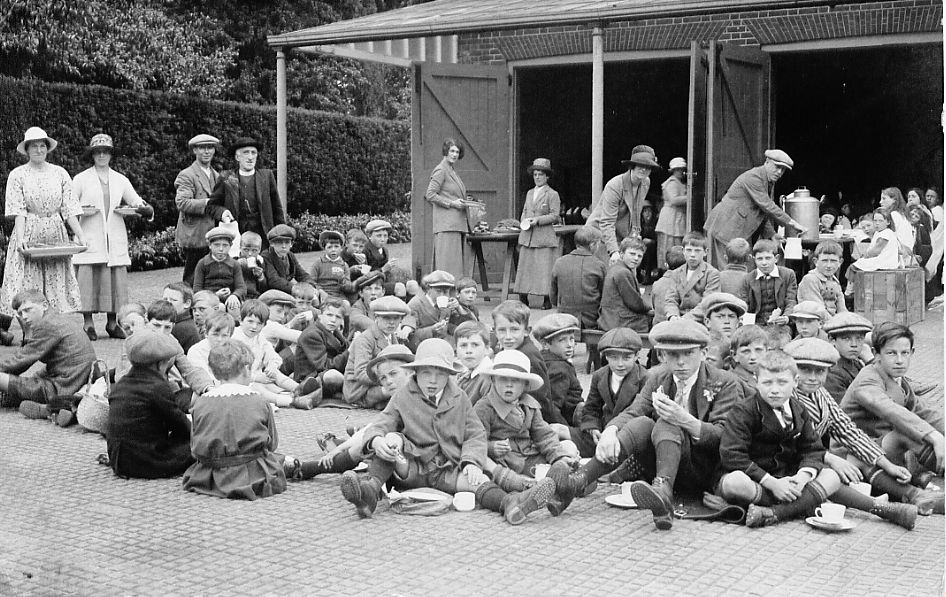 Little Melton & Colney school outing to Colney Hall in the 1920s for Sports in the Park & Tea in the Coach house. The adults standing to the rear, are thought to be, left to right; Miss Wilson, teacher; Miss Cobett, infant class teacher; Tom Crane, Mr. Barclay’s chauffeur; The Rev. Priestland, Vicar of Colney; Rosamund Barclay, daughter of Mr. Barclay; tiny Miss Young; anon; Mrs. Kinch (part obscured by door) head teacher; and finally, Mr. BarclayThe 1851 Census includes details of a Miss Sophia Anna Jane Long, aged 22, daughter of James Long, a house and land proprietor of the village, and his wife Harriet, and describes her rather grandly as ‘governess of a school’. This may or may not have been a room in their house here. The next edition of ‘White’s Directory’ in 1854 does mention a school in the village, with the information that it was ‘a parochial school supported by subscription’ and that the teachers were Charles and Mary Child. We are reasonably certain that this school was again a ‘dame school’ with classes being held in the Childs’ house in what is now called Burnthouse Lane.
Little Melton & Colney school outing to Colney Hall in the 1920s for Sports in the Park & Tea in the Coach house. The adults standing to the rear, are thought to be, left to right; Miss Wilson, teacher; Miss Cobett, infant class teacher; Tom Crane, Mr. Barclay’s chauffeur; The Rev. Priestland, Vicar of Colney; Rosamund Barclay, daughter of Mr. Barclay; tiny Miss Young; anon; Mrs. Kinch (part obscured by door) head teacher; and finally, Mr. BarclayThe 1851 Census includes details of a Miss Sophia Anna Jane Long, aged 22, daughter of James Long, a house and land proprietor of the village, and his wife Harriet, and describes her rather grandly as ‘governess of a school’. This may or may not have been a room in their house here. The next edition of ‘White’s Directory’ in 1854 does mention a school in the village, with the information that it was ‘a parochial school supported by subscription’ and that the teachers were Charles and Mary Child. We are reasonably certain that this school was again a ‘dame school’ with classes being held in the Childs’ house in what is now called Burnthouse Lane.
The recent discovery of an earthenware inkwell on the site seems to add authenticity to the story, and older residents of Little Melton still remember a house, said to have been the old school, (demolished in the early 1960s), which contained a particularly large room. The 1861 Census reveals the presence of a teacher named Mary Goward, aged 20, living in the village with her parents John and Mary and brother James. Both men are described as agricultural labourers, but again we do not know if Mary taught in the village or elsewhere. By 1868 it was a Miss Robertson who was running ‘a village school for boys and girls’ according to Harrod’s Directory.
Two years later an Act of Parliament, Forster’s Education Act, made provision for compulsory education for all children between the ages of 5 and 13, and schools and schooling started to assume the format with which we are familiar today. The act made large sums of money available for the building of school premises and set up boards of governors, elected from the local community, to run them. In 1874 a substantial brick-built school was constructed alongside the road connecting the two villages of Colney and Little Melton, on the parish boundary of the two, ever since known as ‘School Lane’. It was built to accommodate eighty pupils from the two villages and built at the enormous cost, (in those days), of £750. It included living quarters for the schoolmistress and for ‘a maid to wait on her’. Many of the children who attended had fathers who worked as agricultural labourers on the Colney Hall estate, and had to walk the mile or so to and from school in all weathers.
1875
1875
‘The Little Melton and Colney Board School’, was officially opened on 6th September 1875, after Miss Alice Maud Mary Boughey was appointed first mistress at a salary of £60 per annum, and Rev. John Hervey Payne, Rector of Colney, became Clerk to the Board of Governors. Miss Boughey’s maid was to live rent-free and be subject to a quarter’s notice to leave her position.
On the day of opening, twenty-two boys and twenty-seven girls were enrolled, and the following day nine more children attended. By 13th September there were sixty-eight pupils in all on the books, but the problem was getting them to class, and keeping them there, especially in the winter months. Sometimes the snow proved too deep for the children to get through, especially if their boots and coats were inadequate for the conditions, and there was a lot of sickness too. In, 1878, for instance, an outbreak of smallpox closed the school for three whole weeks. Epidemics of what are now considered to be minor diseases, but which were life-threatening then, before immunisation was introduced, regularly caused the school to close. Whooping cough caused numbers to fall so low from October 1888 onwards that the school had to be shut, and was only reopened after the Christmas holiday that year. Children were often kept away to help their parents, or in summertime to help with the harvest, or to take food out to the fields, where their fathers were working long hours. The few pence a week that children could earn by scaring birds in spring, gathering nuts for the pigs in autumn, or helping with harvest was an important supplement to the family income.
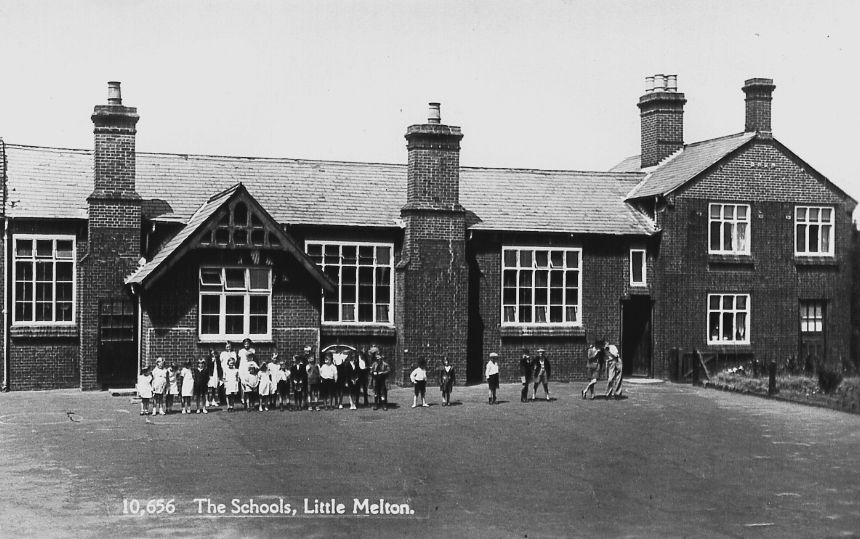 The school in 1930sBy March 1876 the number of children enrolled was 79, and the schools’ inspector recommended that more staff should be employed. Fortunately a 16-year-old pupil teacher, a Miss A. Milk of Stanfield, was appointed in 1877, for soon afterwards Miss Boughey had 96 children on the register! Miss Boughey was to remain at the school for a further ten years, and to depart suddenly in February 1887, whereupon Miss Fryer was promptly appointed headteacher. 1887 also saw the arrival of new tenants at Colney Hall as Hugh Gurney Barclay (of the Norwich banking family), his wife Evelyn and children took up residence there. Like the Scott family before them, they took an immediate interest in the school where so many of the children of their labourers were being educated. The school flourished! HM Inspector of Schools Report of 1899 described the discipline as ‘excellent’ and the instruction as ‘careful and intelligent’. By this time Miss Kate Hall was headmistress and the Punishment Books of her regime can still be seen at the school. The usual punishment, inflicted by Miss Hall herself, was either one or two strokes of the cane on the back of the hand, depending on the seriousness of the offence. The same names constantly recur. Little Eva Bowman, aged 9, was seemingly always in trouble in 1900, and received no fewer than five canings between September and Christmas for mistakes in her knitting, or for blotting her copybook, (yes, literally)! On another occasion Eva and her sister, Ada, also 9, (were they the ‘Terrible Twins’?) were punished for playing in the road and arriving in school a quarter of an hour late. And what did Miss Hall do, two years later, when another little Bowman girl, Winifred, appeared on the scene? She caned her for “copying incorrectly’. Miss Hall must have been very relieved when these children left the school for one in Norwich. Other punishable offences were playing with the ink, copying off other pupils, disobedience, kicking, fighting, climbing over the school wall in playtime and stealing turnips from the adjoining field. Very occasionally, indecent language was cited. Sometimes children arrived at school so hungry that the packed lunches brought by fellow pupils proved too much of a temptation, and were rifled. This led to canings on three occasions for one young pupil. By 1914 a rebellious young lady named Nellie Woods had become the bane of Miss Hall’s life, on many occasions receiving as many as six strokes of the cane for such offences as spoiling her needlework, hitting her sister and playing with the ink. Nellie must have left before 1916 as in that year there were only three entries for the whole year, and none of them concerned Nellie! The admission register for the years 1884 to 1934 also survives and records the names of all the pupils, years of attending school and the date and reason for leaving. In the early years a very common reason was that they were wanted at home, but many children are recorded as leaving the district. This figure tends to be balanced by families coming into the area. In 1901 two children were withdrawn from school as their families were emigrating to Canada. Sadly, every so often, the death of a pupil is noted, a seven-year-old in 1895, an eight-year-old in 1896 and a ten-year-old in 1898.
The school in 1930sBy March 1876 the number of children enrolled was 79, and the schools’ inspector recommended that more staff should be employed. Fortunately a 16-year-old pupil teacher, a Miss A. Milk of Stanfield, was appointed in 1877, for soon afterwards Miss Boughey had 96 children on the register! Miss Boughey was to remain at the school for a further ten years, and to depart suddenly in February 1887, whereupon Miss Fryer was promptly appointed headteacher. 1887 also saw the arrival of new tenants at Colney Hall as Hugh Gurney Barclay (of the Norwich banking family), his wife Evelyn and children took up residence there. Like the Scott family before them, they took an immediate interest in the school where so many of the children of their labourers were being educated. The school flourished! HM Inspector of Schools Report of 1899 described the discipline as ‘excellent’ and the instruction as ‘careful and intelligent’. By this time Miss Kate Hall was headmistress and the Punishment Books of her regime can still be seen at the school. The usual punishment, inflicted by Miss Hall herself, was either one or two strokes of the cane on the back of the hand, depending on the seriousness of the offence. The same names constantly recur. Little Eva Bowman, aged 9, was seemingly always in trouble in 1900, and received no fewer than five canings between September and Christmas for mistakes in her knitting, or for blotting her copybook, (yes, literally)! On another occasion Eva and her sister, Ada, also 9, (were they the ‘Terrible Twins’?) were punished for playing in the road and arriving in school a quarter of an hour late. And what did Miss Hall do, two years later, when another little Bowman girl, Winifred, appeared on the scene? She caned her for “copying incorrectly’. Miss Hall must have been very relieved when these children left the school for one in Norwich. Other punishable offences were playing with the ink, copying off other pupils, disobedience, kicking, fighting, climbing over the school wall in playtime and stealing turnips from the adjoining field. Very occasionally, indecent language was cited. Sometimes children arrived at school so hungry that the packed lunches brought by fellow pupils proved too much of a temptation, and were rifled. This led to canings on three occasions for one young pupil. By 1914 a rebellious young lady named Nellie Woods had become the bane of Miss Hall’s life, on many occasions receiving as many as six strokes of the cane for such offences as spoiling her needlework, hitting her sister and playing with the ink. Nellie must have left before 1916 as in that year there were only three entries for the whole year, and none of them concerned Nellie! The admission register for the years 1884 to 1934 also survives and records the names of all the pupils, years of attending school and the date and reason for leaving. In the early years a very common reason was that they were wanted at home, but many children are recorded as leaving the district. This figure tends to be balanced by families coming into the area. In 1901 two children were withdrawn from school as their families were emigrating to Canada. Sadly, every so often, the death of a pupil is noted, a seven-year-old in 1895, an eight-year-old in 1896 and a ten-year-old in 1898.
1877
1877
By late 1877, 103 children were enrolled, (24 in the Infants Class and nearly 80 in the six standards covering the 7 to 13-year-olds). The school, originally built for children from Little Melton and Colney, was accepting pupils from Cringleford, Hethersett and Earlham by 1900. It was already bursting at the seams, and had been almost from opening. The need for expansion was obvious. Mr George Gleadhill, researching for an article he wrote on the early years of the school’s existence, examined the parish registers of Little Melton for the years 1837 to 1875. These showed that, of the 85 couples who were married during that time, 39 men and 28 women were unable to sign their names in the register. Some families however found it impossible to pay the fee that was demanded by the new Board Schools for their children’s education, or were unwilling to do so. The fees had been decided upon by the Board at its meeting on the 3rd September 1875, and were 4d. per week for the eldest child, and then 2d. for all the other children in the family, if the parents were rated at £10 per annum or more. If the parents were rated at less than £10, the charges were 2d. and 1d. respectively. No child under the age of four was admitted to the school. The attendance record was very important in the school’s early years as it was used, together with the results of tests done by all the pupils, (except the under six-year-olds), to assess the level of the Norfolk County Council grant to the school. Failure by any child to pass the annual test in any one of the three basic subjects meant the loss of 2s. 8d. per year from the school’s grant for that child! The maximum grant that could be obtained was 12s. per head per year for the older children and 6s. 6d. per head for the infants.
The curriculum also included geography, scripture, (regarded as very important), and needlework for the girls. Copying and dictation were also highly thought of. The infants wrote on slates that broke if dropped too often. Arithmetic consisted of addition, subtraction, division and multiplication, and it was arithmetic that the school inspectors reported as giving most trouble to the children. On the whole, however, the school got good reports in its early years. Learning was very much by rote with one qualified teacher, (sometimes a pupil teacher), and monitors, (older pupils considered bright enough to pass their acquired learning on to the younger children), doing the teaching. As state education established itself, the curriculum broadened, and so-called ‘object lessons’ and natural history were added. ‘Object lessons’ involved looking at everyday things in the home, the countryside and around the world, and included such different subjects as ‘iron foundries’ and ‘monkeys’.
1900s
1900s
In 1902 School Boards ceased to exist, as Balfour’s Education Act now gave local authorities the responsibility for running the education service in their own areas. In 1904 the newly created Norfolk Education Committee started to appoint its own school managers, who took over the running of the school, and in so doing, they abolished the old style grants, which had been, in effect, a system of ‘payment by results’. The school curriculum noticeably broadened still further, and School Attendance Officers were appointed to check on absent pupils. Miss Hall would not accept any but genuine reasons for staying away, and the Attendance Man was promptly alerted about missing pupils. The children referred to him as ‘The Kid-hunter’, but no doubt the threat of his appearance was enough to scare the life out of them! Proposed teaching schemes had to be submitted in great detail for approval by the school inspectors. ‘Object lessons’ continued and again show great diversity! Between 1904 and 1907 they included, ‘Public Baths and Washhouses’, ‘Flannelette’, ‘Tapioca’, ‘The Rainbow’, ‘Lighthouses and Lightships’ and ‘How to set a Tea-Table’. The Geography timetable included ‘Latitude and Longitude’, ‘Cardinal Points’, “Volcanoes’, ‘Arctic animals’ and on 8th May 1906, ‘The Earthquake of San Francisco.’ The natural environment was seldom used, but in June 1904 Miss Carpenter is reported as having taken the Lower Division into a hayfield to give them a lesson on ‘Hay’. It did seem to the children, though, that every odd unfilled moment had a scripture lesson inserted, Miss Hall being ‘very religious’ and every school session, morning and afternoon, started and ended with prayers. A (noncorporal) punishment of this time was to be kept in at playtime, morning and afternoon, to write in their best longhand writing, ‘Satan finds more mischief still for idle hands to do’. However things seemed to relax a little on Friday afternoons, and as a welcome relief from the ‘Three Rs’ and scripture, the boys had drawing and modeling in Plasticine, and the girls had sewing or embroidery. Older girls were taken to Hethersett for cookery lessons, going by horse and cart and walking home afterwards, and by 1907 arrangements had been made for the older boys to be instructed in handicrafts at Bawburgh.
In spite of the increasing range of subjects being taught, the Inspectors’ Report of 1910 was critical of the teaching methods used for the older children, which left them seeming dull, compared to the bright infants who enjoyed ‘learning by doing’, and judged that the excessive use of ‘learning by rote’ did not provide enough stimulus with which to fire their imaginations. Many pupils must have longed for the day when they could leave and start work, but the fixing of the school-leaving age at 14 in 1918 ensured that they could not leave before then. In 1921 Miss Hall’s long reign as head teacher came to an end, and Mrs Gertrude Elizabeth Kinch was appointed head and several of the more senior residents of Little Melton still recall her 21 years there. Mrs Kinch’s husband was the village milkman, and her daughter Marie was one of her pupils. She remembered her mother as being very strict, with absolutely no relaxation of the rules towards her own daughter, (quite the reverse in fact!). No doubt the young lad who took mice into school and put them in Mrs Kinch’s desk to get his own back was punished accordingly, but the cane was now only used when children were exceptionally naughty. By the 1920s there were two other teachers at the school beside Mrs Kinch. Miss Cobbett taught the infants and cycled out from Norwich in all weathers. Miss Wilson, who taught the next age group, lived at White Rails Farm at Great Melton. She also cycled, and one (now elderly) gentleman recalls how he used to run behind her bicycle when he went to see his grandparents on Great Melton Road. Mrs Kinch taught the senior children and also conducted the daily PT session in the gravel playground. An earlier generation had been instructed in ‘drilling’ on Army lines, as specified by the Board of Education, by a Sgt. Collins of Ketteringham, who had been paid 2s. 6d. per lesson by the School Board.
All the teaching of the older children was done in one big room, while the infants had their own room. After assembly, with its prayers and calling of the register, a big curtain was drawn across the room and lessons commenced. As in the days of Philip Low, great emphasis was placed on reading, writing and arithmetic, but history and geography had now become equally important. Mrs Kinch took the English classes herself, and was very keen on getting her pupils to speak good English. There was very little emphasis on Science but Marie recalled the Education Committee running a ‘Tree and Bird’ competition, perhaps to foster more interest in natural history. In cold weather a big coal fire with a huge black fireguard was lit by the school caretaker. There was no piped water, so water was drawn from the well, and the lavatories were outside and non-flush, of course. No doubt the children were glad to get back into the warm(er) classroom and did not dawdle too long outside in the winter months. The children sat in groups of three, on forms with desks attached, and with inkwells sunk in the top right hand corners of each section. At lunchtime, most of them went home for their meal, while the rest, who lived too far away, (at the far end of Little Melton or in Colney), had their sandwiches in the school. The children’s health was monitored regularly by the school medical service, and the school dentist came for two days at a time in a mule-drawn caravan with Billy Briggs driving. Teeth were inspected on the first of the two days, and treatment, if required, was carried out on the second day with a parent present. The ‘nit nurse’ also made regular inspections!
1940s
1940s
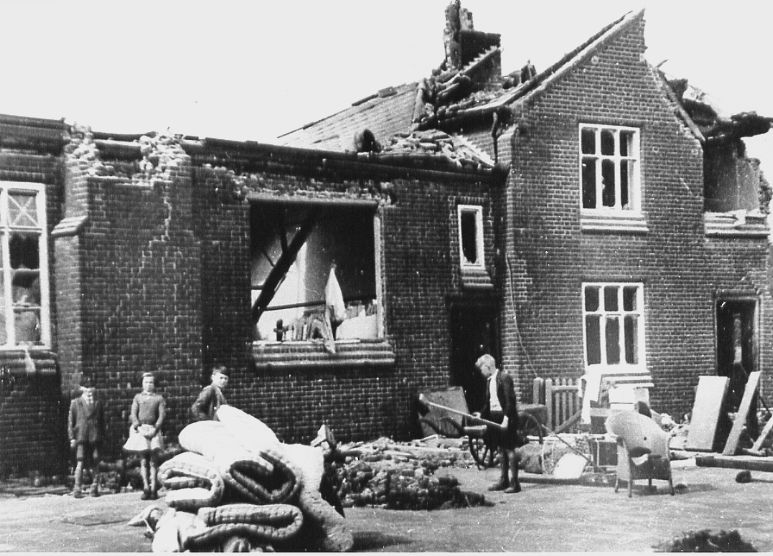 Bombed in 1943 The Barclay family at Colney Hall continued to show their interest in the school, and every so often the children were invited to have a summer picnic in the grounds, and to walk down to the River Yare which flowed through water meadows there. The Hall itself was usually out-of-bounds. The children were also given treats at Harvest and Christmastime with tree presents for everyone, and ‘plenty to eat’, as recalled by one ex-pupil appreciatively. Mr. H. G. Barclay and his tenant farmers also offered jobs to all the school-leavers each year. At one time two lions had been kept at the Hall but a terrible accident had occurred in 1911. The eldest son of the family, Terence, (a lieutenant in the Scots Guards who had survived active service in the Boer War), was clawed in the neck and died of septicaemia. After this, the lions were sent away to a zoo in Dublin.
Bombed in 1943 The Barclay family at Colney Hall continued to show their interest in the school, and every so often the children were invited to have a summer picnic in the grounds, and to walk down to the River Yare which flowed through water meadows there. The Hall itself was usually out-of-bounds. The children were also given treats at Harvest and Christmastime with tree presents for everyone, and ‘plenty to eat’, as recalled by one ex-pupil appreciatively. Mr. H. G. Barclay and his tenant farmers also offered jobs to all the school-leavers each year. At one time two lions had been kept at the Hall but a terrible accident had occurred in 1911. The eldest son of the family, Terence, (a lieutenant in the Scots Guards who had survived active service in the Boer War), was clawed in the neck and died of septicaemia. After this, the lions were sent away to a zoo in Dublin.
September 1939 was to see the start of the Second World War, and when school opened for the Autumn Term, there were 61 local children and 11 evacuees. One of the wartime pupils recalls that the evacuees were often late for school, but never seemed to get into trouble, which did not seem right to the rest of the class. The following April all the pupils were fitted with gas masks, and in January 1941 the first immunisations against diphtheria were given to the children.
Three years later in September 1942, the Managers’ Minute Book of Little Melton Provided School, (as it was now called), records the sad death of Mrs Kinch and the appointment of her successor, Mrs Barbara Buckton of the School House at Baconsthorpe, who was to take up her new post in March 1943. Only just a little over two months later Mrs Buckton and her son, David, were returning to the Schoolhouse from the air raid shelter, at the end of a raid on Norwich, when the School received a direct hit from a stray German bomb. This damaged the whole building beyond repair. David was injured and carried by his mother to the nearest house to summon help. Fortunately his injuries were not too serious, and he and his mother were given temporary accommodation by Mrs Dorothy Broughton, and later by Rev. Frost, until they could be found a more permanent home. School, meanwhile, managed to continue, despite the difficult circumstances. Some pupils were taught in a room at the Rose and Crown Public House, (now the Village Inn), while others were sent to Bawburgh, Hethersett, Cringleford and Great Melton schools. Later, some months after the bombing, a temporary prefabricated school was erected on the site of the bombed school. This ‘temporary’ school lasted for over thirty years until the present school was officially opened in the mid-1970s
1950s
1950s
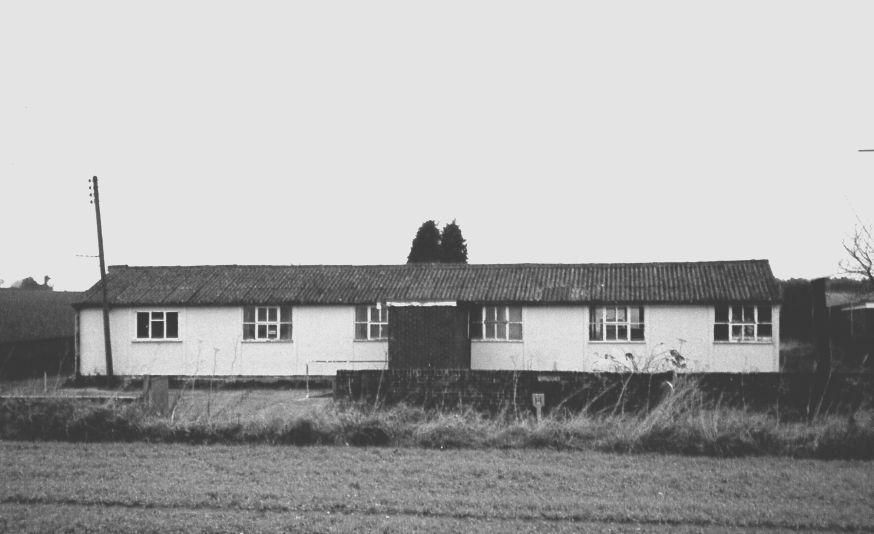 The ‘Pre-fab’ temporary School built on the site of the ‘Bombed’ school, demolished in the late 1970s
The ‘Pre-fab’ temporary School built on the site of the ‘Bombed’ school, demolished in the late 1970s 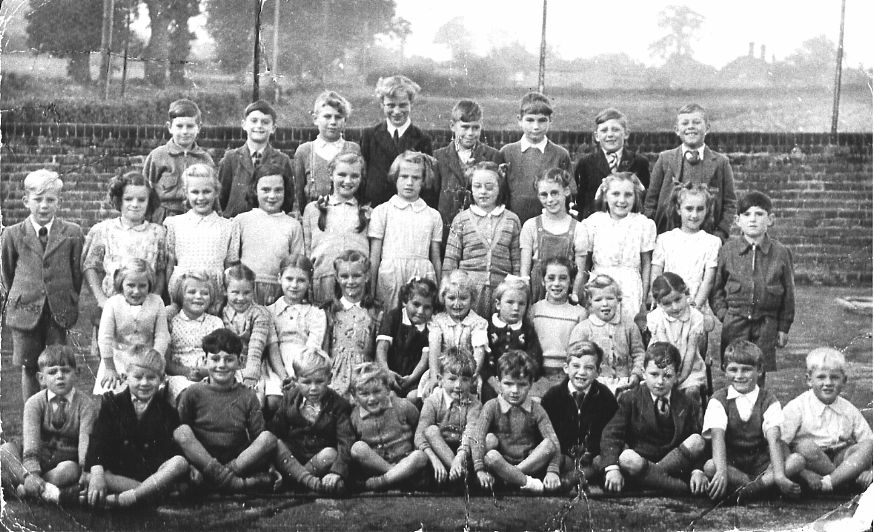 Pupils in 1953 - click to see who they are, some still live in the village in 2020!It would probably have lasted a great deal longer, had it not been for the persistence of the then head, George Gleadhill! After combing through the Statute Books, he was able to find post-war legislation that provided for the rebuilding of all public buildings destroyed by enemy action, Little Melton School having the dubious honour of being the only school in Norfolk to be destroyed in this way. Very few children from Colney were now on the school roll, so a central site on a former orchard next to the Rose and Crown in Little Melton was chosen for the erection of the new building, and just under 100 years after the opening of the old Victorian school, the new one came into use, again substantially built of brick. In March 1972 “The Eastern Daily Press” reported that Norfolk Education Committee had allocated £36,400 to build the school and work commenced in May 1973. The ‘prefab’ closed for half-term on 23rd May 1974, and school opened in the new premises on 3rd June 1974, with 81 pupils in four classrooms.
Pupils in 1953 - click to see who they are, some still live in the village in 2020!It would probably have lasted a great deal longer, had it not been for the persistence of the then head, George Gleadhill! After combing through the Statute Books, he was able to find post-war legislation that provided for the rebuilding of all public buildings destroyed by enemy action, Little Melton School having the dubious honour of being the only school in Norfolk to be destroyed in this way. Very few children from Colney were now on the school roll, so a central site on a former orchard next to the Rose and Crown in Little Melton was chosen for the erection of the new building, and just under 100 years after the opening of the old Victorian school, the new one came into use, again substantially built of brick. In March 1972 “The Eastern Daily Press” reported that Norfolk Education Committee had allocated £36,400 to build the school and work commenced in May 1973. The ‘prefab’ closed for half-term on 23rd May 1974, and school opened in the new premises on 3rd June 1974, with 81 pupils in four classrooms.
It was a great relief for teachers and children to get away from the privations of the prefab. school, where, initially, pupils ranging in age from 5 to 11 years had had to be crowded into two classrooms. Later, a mobile classroom had been added to make a third teaching area, but there had been no separate dining facilities, and every lunchtime all the desks had to be cleared of books and papers to double up as dining tables. The temporary school had tortoise stoves in the corners, and pupils any distance from them felt no benefit at all, and the tin roof made it a very noisy building in heavy rain! For a few years after the school moved out, this building enjoyed a new lease of life as Little Melton Village Hall, before a new building superseded it too, the present purpose-built one on Mill Road. In 1990 the prefabricated building was demolished and two houses built on the site, leaving little evidence of the century of dedicated teaching that had gone on there, nor of that terrible night when German bombs destroyed the old Victorian building.
At the time the present school was opened, the curriculum was very much the responsibility of the Head Teacher, though approval had to be obtained from the appropriate county council advisors in each subject, before teaching could be put into practice. Very high standards were achieved, and one year the school received the highest percentage pass rate for any school in Norfolk in the 11+ examination, which determined which pupils were selected for Grammar Schools. Every year, the school regularly sent eight or more pupils to Wymondham College, the local Grammar School. By now the staff had expanded to comprise the head, four teachers, the school secretary and welfare assistant, with help also coming from parents and other members of the local community. The school roll at times was approaching one hundred and twenty pupils aged from four to eleven. Talks from the local policeman, from farmers’ wives and fire service personnel, and visits to farms were now used to introduce children to the life and work of their community. The reputation of the school attracted visiting groups of teachers from as far afield as Japan, Norway, Russia and Yugoslavia. By now the cane had been replaced by a fictitious slipper, which fortunately never actually needed to be used! At Christmas Santa arrived on a tractor belonging to the Chairman of Governors, and brought an individually wrapped and named present for every child. It was a far cry from the start of the century when the Barclay family had, in some years, given lace-up boots to every child in the school and, other years waterproofs, because their parents could not afford such necessities of life.
1960s and later
1960s onwards
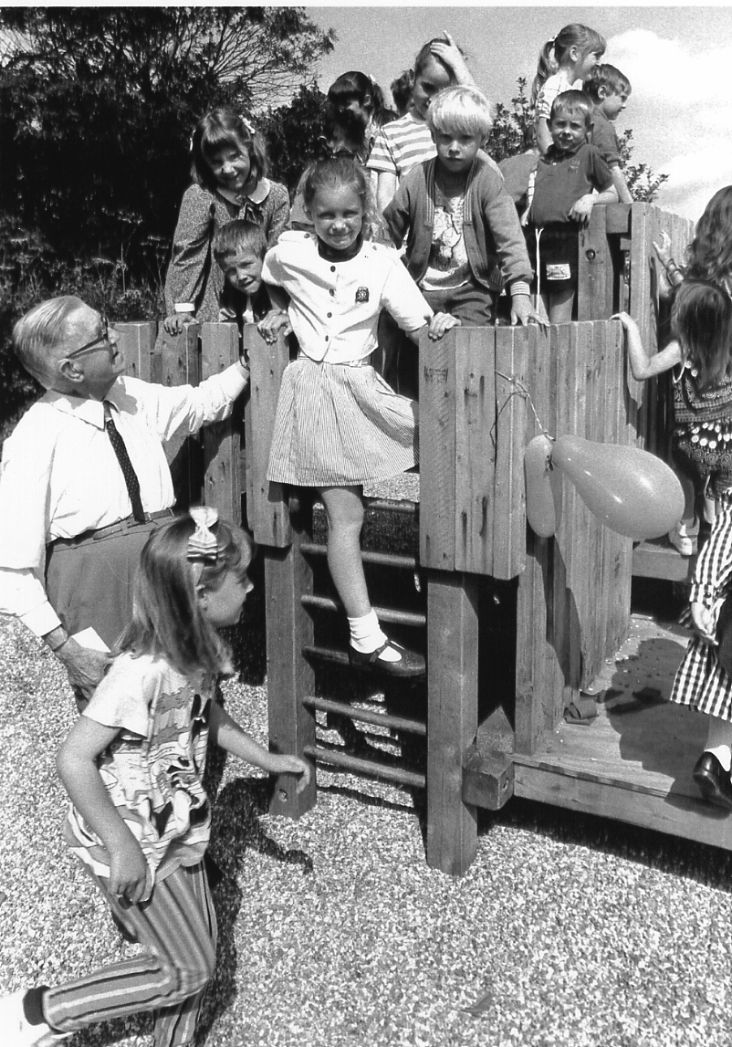 The opening of the School Play Equipment, 1992. Masterminded by Heather Lenton and Rosie Stanley, fundraising included proceeds from the Little Melton Light Railway. The children are being watched over by village historian and long serving churchwarden, Joe Day.In the mid-1960s, the population of Little Melton began to rise rapidly, following the erection of much new housing, and the village seemed to be alive with children. The school had been designed for 75 pupils in 1973, but had 97 on the register by 1978! In line with changes that were taking place in the education system in Norfolk and elsewhere, a decision was made to take pupils only between the ages of 4 and 8, at which age they would transfer to the Hethersett County Middle School. In this way, in 1979, the Little Melton County First School came into existence, with Mr Geoffrey Hill as head. This change in the system was to lead to such a big drop in the number of pupils that by 1981 there were serious worries that the school might have to be closed, as there were only 48 children attending. House-building continued, however, bringing many families with young children into the village, so fortunately numbers began to rise steadily, putting an end to all talk of possible closure. In 1991 Mr Hill retired, and the present head, Mrs Anne Clements, was promoted from Acting Head to Head teacher.
The opening of the School Play Equipment, 1992. Masterminded by Heather Lenton and Rosie Stanley, fundraising included proceeds from the Little Melton Light Railway. The children are being watched over by village historian and long serving churchwarden, Joe Day.In the mid-1960s, the population of Little Melton began to rise rapidly, following the erection of much new housing, and the village seemed to be alive with children. The school had been designed for 75 pupils in 1973, but had 97 on the register by 1978! In line with changes that were taking place in the education system in Norfolk and elsewhere, a decision was made to take pupils only between the ages of 4 and 8, at which age they would transfer to the Hethersett County Middle School. In this way, in 1979, the Little Melton County First School came into existence, with Mr Geoffrey Hill as head. This change in the system was to lead to such a big drop in the number of pupils that by 1981 there were serious worries that the school might have to be closed, as there were only 48 children attending. House-building continued, however, bringing many families with young children into the village, so fortunately numbers began to rise steadily, putting an end to all talk of possible closure. In 1991 Mr Hill retired, and the present head, Mrs Anne Clements, was promoted from Acting Head to Head teacher.
You can read about Littel Melton Primary School today on their website
https://www.little-melton.org.uk/home/history/67-schooling?start=1#sigProIdbb2587b626


